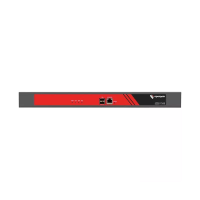Chapter 3: Initial System Configuration
38 Console Server & RIM Gateway User Manual
HTTP The HTTP service allows the Administrator basic browser access to the Management Console. It is
recommended the HTTP service be disabled if the console server is to be remotely accessed over the
Internet.
Telnet This gives the Administrator telnet access to the system command line shell (Linux commands). While
this may be suitable for a local direct connection over a management LAN, it is recommended this
service be disabled if the console server is to be remotely administered. This service may also be
useful for local Administrator and the User access to selected serial consoles
SSH This service provides secure SSH access. It is recommended you choose SSH as the protocol where
the Administrator connects to the console server over the Internet or any other public network. This will
provide authenticated communications between the SSH client program on the remote computer and
the SSH sever in the console server. For more information on SSH configuration refer Chapter 9 -
Authentication.
There are also a number of related service options that can be configured at this stage:
SNMP This will enable netsnmp in the console server, which will keep a remote log of all posted information.
SNMP is disabled by default. To modify the default SNMP settings, the Administrator must make the
edits at the command line as described in Chapter 15 – Advanced Configuration
TFTP/FTP If a USB flash card or internal flash is detected on an ACM5000, ACM5500, IM4200 or IM4004-5
advanced console server, then enabling this service will set up default tftp and ftp server on the USB
flash. These servers are used to store config files, maintain access and transaction logs etc. Files
transferred using tftp and ftp will be stored under /var/tmp/usbdisk/tftpboot
Ping This allows the console server to respond to incoming ICMP echo requests. Ping is enabled by
default, however for security reasons this service should generally be disabled post initial configuration
Nagios Access to the Nagios NRPE monitoring daemons
NUT Access to the NUT UPS management daemons
And there are some serial port access parameters that can be configured on this menu:
Base The console server uses specific default ranges for the TCP/IP ports for the various access services
that Users and Administrators can use to access devices attached to serial ports (as covered in
Chapter 4 – Configuring Serial Ports). The Administrator can also set alternate ranges for these
services, and these secondary ports will then be used in addition to the defaults.
The default TCP/IP base port address for telnet access is 2000, and the range for telnet is IP Address:
Port (2000 + serial port #) i.e. 2001 – 2048. So if the Administrator were to set 8000 as a secondary
base for telnet then serial port #2 on the console server can be telnet accessed at IP Address:2002
and at IP Address:8002. The default base for SSH is 3000; for Raw TCP is 4000; and for RFC2217 it
is 5000
RAW/Direct You can also specify that serial port devices can be accessed from nominated network interfaces
using Raw TCP, direct Telnet/SSH, unauthenticated Telnet services etc
Click Apply. As you apply your services selections, the screen will be updated with a confirmation message:
Message Changes to configuration succeeded

